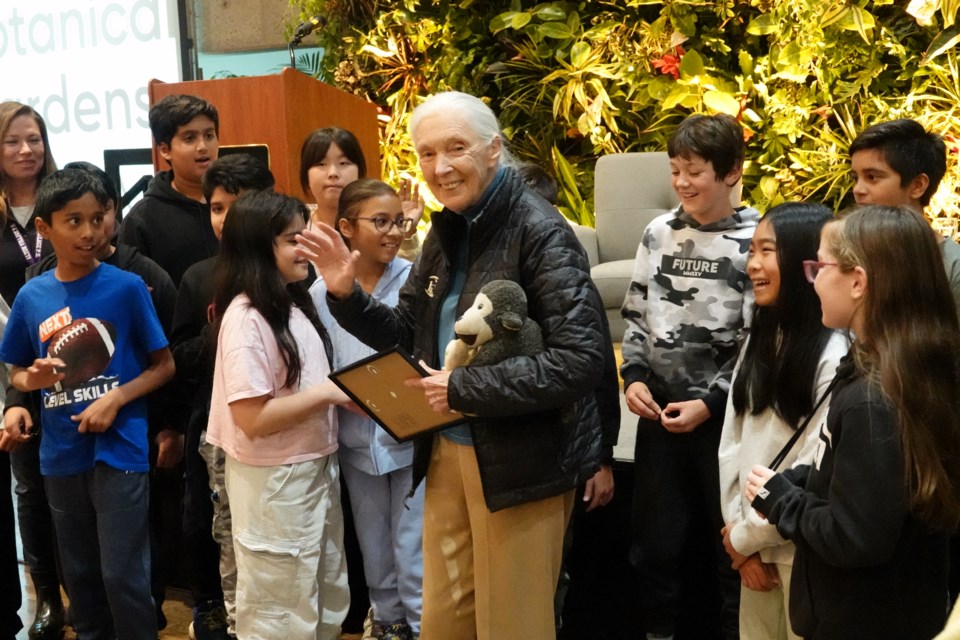It’s difficult for a youngster to decide how to make a difference in the world, but Dr. Jane Goodall gave local students plenty of great suggestions.
The world-renowned environmentalist spoke to school children Grades 4 to 6 about the importance of working together to make change.
She was at the Royal Botanical Gardens this morning where some 400 students welcomed her with lots of clapping – 607 classes had applied for the few available spots – during EcoFest. This evening, she will be speaking to adults who also applied lottery-style for a chance to see the woman who’s best known for her work with chimpanzees.
Children listened intently as the United Nations Messenger of Peace told them of her first experiences with chimpanzees.
When she was just 10 years old, she said, she listened to her mom. “I had a wonderful mother. Her advice was: work really hard, take advantage of opportunities and never give up.”
Like other youngsters, she said, she read about Tarzan, “because that was 80 years ago and we didn’t have movies.”
She was inspired to go to Africa, where she studied chimpanzees alongside Dr. Louis Leaky in Gombe National Park in Tanzania.
“Chimpanzees have 98.6 per cent of the DNA that makes us human, and that makes them chimp,” she said. “I would have studied any animal.”
But the chimpanzees stand out in her mind as the interaction that had the greatest impact on her, she said, answering questions from several schools, including that one from Alton Village Public School.
“They were very scared, they’d never seen anything like me before,” she said, and for four months, she was banished. That was frightening because she only had six months to spend there at that time. Finally, one chimpanzee started to lose his fear of her.
“He had white hair and gentle eyes, and I called him David Greybeard,” she said. “I started to follow him, and he let me get a little bit closer.”
But she had to get through thick vegetation, thorns and vines and it took her a while to get to him. She thought he would be long gone by the time she made it through. Instead, he was sitting there, looking back toward her. She saw a red oil nut on the ground near him and offered it to him, but he turned away from it.
“He turned to me, reached out his hand and squeezed my fingers. We connected in a way that must have been joint communication. He understood my motives were good and understood me and it was a very special moment.”
She brought her stuffed monkey Mr. H, who stayed on the podium while she spoke. Named after Gary Haun, a man who lost his vision at the age of 21, the monkey is a symbol of hope and a reminder of a tenacious spirit.
She told her young audience that she’s had him for 32 years, and he has been to 61 of the 63 countries she’s visited; in total she has visited 70 countries. “Children around the world have petted him.”
She encourages children to do what they can and what they are passionate about.
“Respect each other, animals, and the environment and have compassion whenever you can,” she said.
She encouraged them to “slow down the eating of the globe,” suggesting being vegetarian is helpful to the world since meat-eating is taking its toll on the ecosystem.
“Being a vegetarian will have a big impact,” she explained because of the difficulty in growing food to sustain animals, “to feed these animal prisoners to get meat to the table. Eating less is really helpful for the environment.”
She said the world’s ecosystem is precious. “I know most about the forest ecosystem. Every single animal has a role to play and they are all interconnected.
“Think of a spider web and when a species disappears, one strand of the web is broken and it will eventually collapse.”
She said students can suggest their parents buy things that aren’t cruel to the environment, whether that’s the item itself or its packaging.
She suggested students can walk or use bicycles, catch the bus, pick up litter, plant trees and more.
Further, she said they need to find something they are most interested in when choosing a field to study.
“Find something to be absolutely passionate about, and never feel ashamed if you change from one thing to another,” she said. “People may think it’s peculiar if you change but be absolutely sure you do what you want to do.”
She doesn’t think she would change anything in her life and that she’s inspired by her youth group, Roots and Shoots. In Canada, more than 12,000 young people are actively involved in projects that inspire the next generation of conservation leaders.
“Seeing them, they’re so passionate with their shining eyes,” she said.
Students heard about the Jane Goodall Institute, a global community conservation organization founded in 1977. As she told the students, it’s the collective power of each person’s actions to help save the world we all share.
The youngsters took what she said to heart. Following the talk, some of the students from Alton Village Public School got to meet with her on stage. Jake presented her with some artwork he had created.
Grade 5 student Callan Jones said he was surprised to learn how many countries she had visited. He also plans to ask some of his friends to help him in a quest to clean up litter.
“I might ask some people to pick up 20 things, or maybe 50,” he said.



